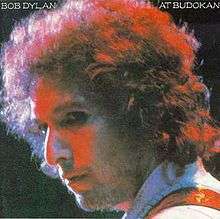Bob Dylan at Budokan is a live album by American singer-songwriter Bob Dylan, released April of 1979 on Columbia Records. It was recorded during his 1978 world tour and is composed mostly of the artist's "greatest hits". The performances in the album are radically altered from the originals, using the same musicians that backed Street-Legal, but relying on a much larger band and stronger use of brass and backup singers. In some respects the arrangements are more conventional than the original arrangements and the album was criticized for being so. At the same time that it was criticized for being too polished, it was criticized for being too sloppy. For a few critics, such as Janet Maslin of Rolling Stone, the differences between the older and newer arrangements had become less important.[1]
Recording and releases
The audio recording is from two different shows on February 28 and March 1, 1978. Columbia Records released this double LP in North America on August 21, 1978; the original issue was limited to the Japanese market. Later that year, it was released in Australia. On April 23, 1979, spurred by extensive importing and at least one counterfeit European edition, Columbia released the album to worldwide markets. The shows were the fourth and fifth in an eight-show appearance at Nippon Budokan Hall in Tokyo, Japan.
Reception
Bob Dylan at Budokan received some of the worst reviews of Dylan's career. Critically savaged, it was derided as "slick" and "sterile."
In a sarcastic review published in his "Consumer Guide" column, Robert Christgau gave the album a C+ rating, writing "I believe this double LP was made available so our hero could boast of being outclassed by Cheap Trick, who had the self-control to release but a single disc from this location." [3] Critic Jimmy Guterman named it one of the worst albums ever released in the history of rock.
However, the album received stronger reviews in Europe, and critic Janet Maslin (then a music critic for Rolling Stone magazine) defended the album in her review. "The method here is hit-or-miss, and the results are correspondingly spotty," Maslin wrote. "The fire and brimstone are behind Dylan, [but] this hardly means the fight has gone out of him: Bob Dylan at Budokan is a very contentious effort—and, for the most part, a victorious one."[1] Ironically, fire and brimstone were to again become very much a part of Dylan's music, with the release of his gospel rock album Slow Train Coming later in 1979.
Bob Dylan at Budokan reached #13 in the US and went platinum, while simultaneously peaking at #4 in the UK.
Track listing
All songs written by Bob Dylan, except where noted
Personnel
- Bob Dylan — vocals, guitar, harmonica
- Steve Douglas — saxophone, flute, recorder
- Steven Soles — acoustic guitar, backing vocals
- David Mansfield — pedal steel guitar, violin, mandolin, dobro, guitar
- Billy Cross — lead guitar
- Alan Pasqua — keyboards
- Rob Stoner — bass, backing vocals
- Ian Wallace — drums
- Bobbye Hall — percussion
- Ed Rash — tambourine
- Debi Dye, Jo Ann Harris, Helena Springs —backing vocals
- Technical personnel
References
